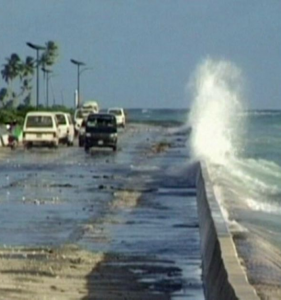Can climate resilience infrastructure be public/private projects?
No. Washington’s current infrastructure philosophy
is unsuited for our climate resilience needs.
 It’s October and, like me, you may be waiting impatiently for our leaders in Washington to announce an infrastructure plan, one that will build some serious protections against the threats we face from warming. Maybe you hope for sea walls and raised waterfront facilities to fight a rising ocean, or higher levees to help with river flooding, or some runoff ponds and other green infrastructure to reduce polluted stormwater from heavier rainstorms.
It’s October and, like me, you may be waiting impatiently for our leaders in Washington to announce an infrastructure plan, one that will build some serious protections against the threats we face from warming. Maybe you hope for sea walls and raised waterfront facilities to fight a rising ocean, or higher levees to help with river flooding, or some runoff ponds and other green infrastructure to reduce polluted stormwater from heavier rainstorms.
Washington’s plan is still vague, but it emphasizes a form of financing that’s been tried for non-climate-related projects. The idea: what if we could not only be guaranteed that a deteriorating local bridge or highway would be maintained at no cost to taxpayers but it could also provide our state or city with a big wad of cash up front to spend on other needs? Take the deal the State of Indiana made in 2006 for example. A private company would maintain the whole of the Indiana Tollway across the state in return for collecting its tolls. And the contractor paid the state $3.8 billion up front to do it!
It’s called a public-private investment, and Vice President Pence is leading the charge to have 80% of the Administration’s new infrastructure ‘spending’ be in the form of such partnerships. This would be a big change for America. Hoover Dam, the Interstate highway system, the Erie Canal, and virtually all public projects have been built with taxpayer dollars. Now the pubic-private plan to be debated in Congress calls for four-fifths of infrastructure funding to come, not from the taxpayer, but from private investors.
There are several reasons we taxpayers should be skeptical.
1) First, public/private projects offer no savings; in fact, the profits and higher interest rates that need to be added to the cost structure of a privately-owned project can raise, not lower, its costs. There are plenty of disastrous examples of private companies taking over public assets. Case in point: that Indiana Toll Road. At the start, the company maintained the road and kept the tolls, but when revenues dropped they simply filed for bankruptcy, returning the highway back to Indiana taxpayers. Water and sanitation systems have seen the same problems. Between 2000 and 2014 fifty-nine cites that had sold off their systems to the private sector reclaimed them after serious disappointments.
2) For climate resilience projects there’s a bigger reason to worry about relying on the public/private approach. Highways and water supplies have revenues. Many climate defenses have none. Where will a private owner get its payback for building structures to control stormwater, storm surge, or sea level rise? Nobody pays tolls for these things; the payment has to come through local taxes. And here’s the biggest drawback: private investors who jump at the chance to own roads, bridges, and supply systems that have tolls, fares or water rates will be far less interested in building a levee, a stormwater runoff landscape, or artificial reef that doesn’t have its own revenue stream.
Private investor preferences do not correlate with national needs, and private funding is likely to push America’s most important climate resilience projects even further towards the bottom of the priority list than Washington’s climate denial attitudes do already. We can lobby our senators and representatives for infrastructure funding – more direct and less public/private. But we also need to tell our neighbors that most of the climate resilience construction we need for our town won’t be coming from Washington, so we better start planning how to finance it locally.

